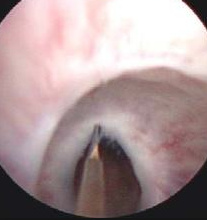Scientific Editor: Editorial Board ISUD website
- What is Optical Urethrotomy?
- When is it performed?
- What sort of preparation is required?
- How is the procedure performed?
- What about after the procedure?
- What is the effect on patient’s quality of life?
What is Optical Urethrotomy?
Optical Urethrotomy is the endoscopic procedure to treat urethral stricture (narrowing).
When is it performed?
Optical Urethrotomy is performed to treat urethral stricture. It is a therapeutic option for urethral strictures of less than 1,5cm
What sort of preparation is required?
Upon hospital admission, preoperative preparation includes blood tests, chest X-ray and ECG (electrocardiogram). In case you are on anticoagulant therapy, it may be required to interrupt your anticoagulant therapy a few days before the operation. You should always consult your Cardiologist, for there may be need to replace anticoagulants with injections in the abdominal region.
How is the procedure performed?
The procedure requires general or spinal anesthesia. In the beginning, the patient is placed in the gynecological examination position, the region is cleansed and the urethra lubricated. A mini camera is inserted through the urethra to locate the stenosed area. With the use of an instrument attached to the camera, the stenosed area is opened up. At the end of the procedure, a catheter is placed.
Length of hospital stay depends on the extension of the damage. However, on average it is estimated to be about 2 days.
The time of catheter removal depends on the extension, location and cause of the stenosis, ranging from 1 to 6 weeks. Alternative surgery is Urethrotomy with the use of laser technology. Studies have shown that both procedures give similar results.
What about after the procedure?
During the first postoperative days, the patient may feel a burning sensation in the urethra and present blood in the urine (hematuria). Also, the catheter may cause bladder spasm and intense pain, which lasts only a few seconds. These symptoms can improve with appropriate pharmaceutical agents. When hematuria occurs, the catheter is kept and continuous bladder irrigations are applied for as long as required.
Once the catheter is removed, the patient’s urinary function is checked. An ultrasound is performed to make sure there is no post-void residual urine (i.e. no urine left in the bladder after voiding).
Upon discharge from hospital, you will be given specific written instructions about:
- what antibiotic regimen to take
- how long to abstain from physical strain
- how important it is to drink plenty of fluids
You should necessarily consult your Cardiologist about when to restart your previous anticoagulant treatment.
What is the effect on patient’s quality of life?
Most patients do not face any problem after the procedure. However, the most common complication, is reported to be recurrence of urethral stricture.
With regard to nutrition after surgery, you should take about 1.500ml fluids/day and avoid coffee, alcohol and smoking, for they may cause irritative symptoms.


